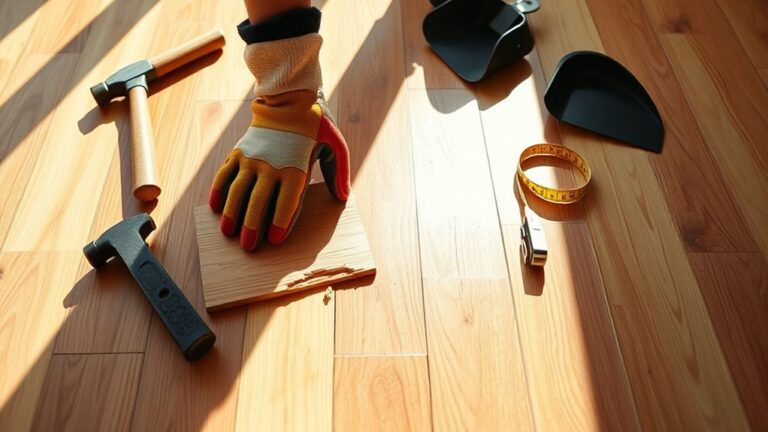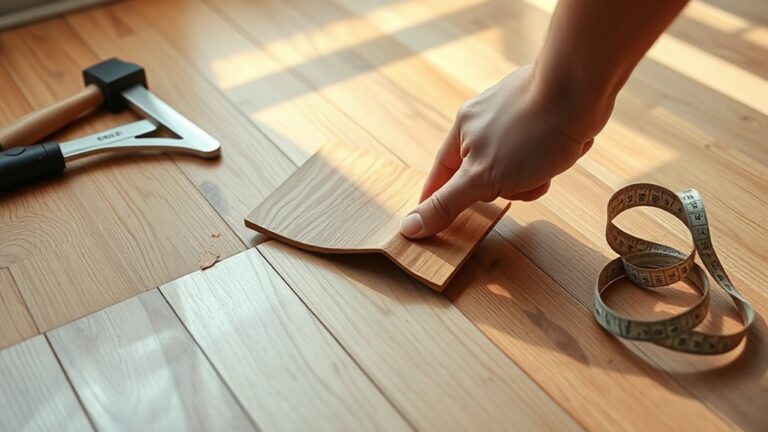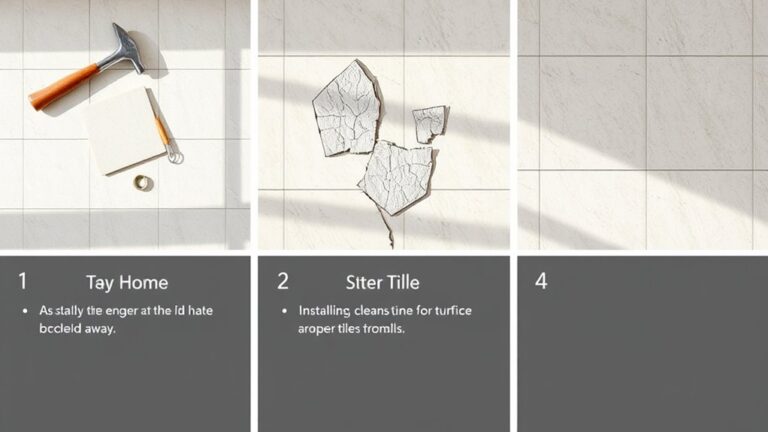Fixing scratches on hardwood flooring is essential for preserving its charm. Start by evaluating the damage; light scratches can often be tackled with stain markers or wax sticks, while deep scratches may need wood filler and sanding. For quick touch-ups, a mix of apple cider vinegar and olive oil can mask minor imperfections. Always use protective pads under furniture to prevent future scratches, and maintain a regular cleaning routine to keep debris at bay. If the damage seems extensive, it's wise to consult a professional for a thorough evaluation. There's plenty more useful advice to help you restore your floors beautifully.
Assessing Scratch Damage
When it comes to evaluating scratch damage on your hardwood floors, the first step is to identify the type of scratch you're dealing with. You'll typically come across light scratches, which are usually no deeper than 1/16-inch. These superficial scratches can often be addressed with simple DIY repair methods. On the other hand, deep scratches may require more extensive repairs, especially if they penetrate the finish and reach the wood itself.
Next, consider the finish type of your hardwood. If you have site-finished flooring, you might find it easier to repair, as it usually has fewer protective layers compared to pre-finished hardwood. This difference can influence your repair methods considerably. As you evaluate the extent of the damage, note that deep gouges demand more intensive work than light scratches, so understanding this distinction is essential for effective repairs.
Documenting the condition of your floors is also a smart move. By recording areas needing urgent attention, you can create a clear repair plan. If you notice extensive damage that goes beyond what you feel comfortable repairing, seeking a professional evaluation is advisable. Professionals can pinpoint the appropriate repair solutions based on their expertise, ensuring that your hardwood floors regain their beauty without compromising integrity. Being proactive in evaluating scratch damage not only helps preserve your floors but also empowers you to make informed decisions about their care.
Techniques for Minor Scratches
How can you effectively tackle minor scratches on your hardwood floors? Fortunately, these scratches usually only penetrate the protective coating and don't damage the wood itself, making them simpler to fix. One popular method is to use stain markers or blending pencils that match the color of your floor. Simply apply the marker to the scratch, and you'll quickly see an improvement.
Another effective technique involves wax sticks. These can fill in the scratches and help restore the shine of your wood floors. Just pick a wax stick that closely resembles the color of your flooring, press it into the scratch, and smooth it out.
If you're looking for a natural solution, consider mixing equal parts apple cider vinegar and olive oil. Apply the mixture to the scratched area and let it sit for about 24 hours before buffing it out. This method can help mask minor scratches and enhance your floor's appearance.
For those small, surface-level scratches, a Magic Eraser can work wonders without damaging the finish. Just gently rub the eraser over the scratch, and you should see it vanish.
Lastly, regularly applying a clear water-based polyurethane creates a protective coating that fills in minor scratches and enhances the overall shine of your hardwood floors. By using these techniques, you can effectively repair scratches on wood floors, keeping them looking beautiful for years to come.
Repairing Deep Scratches
While minor scratches on hardwood floors can often be fixed with simple techniques, deep scratches present a more significant challenge that requires a careful approach. Deep scratches, exceeding 1/16-inch in depth, demand a more intensive repair method to restore your floor's beauty.
Start by thoroughly cleaning the area to remove any debris or dust. This step is essential, as it guarantees the wood filler adheres properly. Once the area is clean, you'll want to apply wood filler that matches the color of your floor. Using a putty knife, gently spread the filler into the scratch, filling it completely. Allow the wood filler to dry completely—this is important for achieving a smooth finish.
After it's dry, it's time for sanding. Lightly sand the area until it's level with the surrounding wood, assuring a seamless blend. Be careful not to sand too aggressively, as you don't want to damage the surrounding floor. Once you've achieved a smooth surface, apply a matching stain to help the repair blend in with the existing wood finish.
If necessary, finish off the repair with a protective coating to safeguard the area against future wear. If you find the damage extensive or the repair feels too complex, don't hesitate to think about hiring a professional. They have the expertise to guarantee a high-quality finish, bringing back the original beauty of your hardwood floors.
Preventing Future Damage
To keep your hardwood floors looking new, start by placing protective rugs or mats in high-traffic areas. You should also attach felt pads to furniture legs to prevent scratches when moving items around. Regularly sweeping and vacuuming will help eliminate dirt and debris that can cause damage over time.
Protective Rugs and Mats
When it comes to safeguarding your hardwood floors, placing protective rugs and mats in high-traffic areas is essential. These coverings absorb impact and markedly reduce wear, extending the lifespan of your beautiful flooring. By choosing the right rugs, you can protect your investment and enjoy your living space with peace of mind.
Here are three key benefits of using protective rugs:
- Prevent Slipping: Rubber or felt-backed mats keep your family safe by preventing slips and falls, especially in busy areas like entryways and kitchens.
- Accumulate Dirt: Area rugs trap dirt and debris, preventing them from scratching your hardwood surface as you walk through your home.
- Minimize Scratching: Rugs made from natural fibers like cotton or wool provide a softer surface, reducing the risk of scratches compared to synthetic options.
Furniture Pads Usage
Using furniture pads is one of the simplest yet most effective ways to protect your hardwood floors from scratches and damage. These pads, typically made of felt or rubber, act as a buffer between furniture legs and your hardwood floors, considerably reducing friction during movement. By investing in quality furniture pads, you can reduce the risk of scratches by up to 90%, making them vital for protecting hardwood.
To guarantee peak protection, make sure the pads are appropriately sized for your furniture legs. Larger pads provide more surface area, helping to distribute weight evenly and minimize the risk of gouges. Regularly inspect and replace worn-out pads, as maintaining their integrity is essential for ongoing protection against wear and tear.
Implementing a policy of using furniture pads on all movable items in your home will not only help prolong the life of your hardwood floors but also maintain their aesthetic appeal. This simple maintenance step can save you from costly repairs down the line and keep your floors looking beautiful for years to come. So, don't overlook this easy yet impactful solution—your hardwood will thank you!
Regular Cleaning Routine
A regular cleaning routine is essential for preserving the beauty and integrity of your hardwood floors. By committing to a consistent schedule, you can effectively prevent scratches and damage that detract from your home's charm. Here's how to keep your floors looking their best:
- Regularly sweep or vacuum: Aim for at least once a week to remove debris that can scratch the surface.
- Mop with a soft cloth: Use a damp cloth and a gentle wood cleaner every 1-2 weeks to maintain the finish and prevent buildup.
- Utilize door mats: Placing mats at entryways greatly reduces dirt and grit tracked onto your hardwood floors.
Additionally, consider applying felt pads under furniture legs to avoid scratches from movement. Maintaining consistent humidity levels between 30% and 50% also helps prevent wood expansion and contraction, which can lead to damage over time. By following this cleaning routine, you'll protect your hardwood floors, keeping them vibrant and scratch-free, allowing you to enjoy your space to the fullest. Embrace the freedom that comes with well-maintained floors, and let your home shine!
When to Seek Professional Help
Scratches on hardwood floors can be more than just a cosmetic issue; they can indicate underlying problems that require professional intervention. If you notice that the wood is exposed due to finish removal or severe damage, it's wise to seek professional repair services. DIY fixes might not cut it, especially if the damage is extensive, as a professional's expertise can save time and guarantee a high-quality finish.
Widespread damage across large areas of your hardwood floor often necessitates an expert assessment to determine the most effective repair strategy. Professionals have specialized tools and skills to handle significant gouges and can utilize advanced techniques such as sanding and refinishing to restore your floor's beauty.
If your DIY attempts haven't yielded satisfactory results, don't hesitate to call in the experts. They can tackle complex repairs with ease, especially if you have intricately patterned or high-value hardwood floors. Maintaining the aesthetic integrity of your flooring is essential, and experienced professionals can help prevent further damage that might arise from improper repairs.
Choosing the Right Repair Products
When you're choosing repair products for hardwood scratches, it's essential to take into account the type of finish on your floors. You'll want to match the repair product's color as closely as possible to your wood to guarantee a seamless look. By selecting the right products, you can effectively restore your flooring's beauty and integrity.
Types of Repair Products
Choosing the right repair products for hardwood floor scratches can greatly influence the outcome of your restoration efforts. When tackling those unsightly marks, you'll want to evaluate a few key options tailored to your needs:
- Stain Markers: Perfect for minor surface scratches, these products can easily blend into your floor color, making the damage less noticeable.
- Wax Sticks: Similar to stain markers, wax sticks are ideal for quick fixes and can fill in shallow scratches effectively.
- Wood Fillers: For deeper scratches, using a wood filler that matches your hardwood is essential for a durable repair.
Matching Floor Color
To achieve a successful repair on your hardwood flooring, matching the floor color is essential for a seamless finish. Start by identifying the exact type of wood and finish of your floor, as different woods absorb wood stains and fillers uniquely. This variance can dramatically affect your final color match.
Using specialized repair products like wood putty, stain markers, or blending pencils designed for your specific floor type will enhance your chances of success. If you're facing a more complex repair, consider the severity of the damage when selecting your products. Mixing different shades of wood stain can help you get closer to your existing color, but always test any mixture on a small, inconspicuous area first.
For those who want to guarantee precision, a color matching service or consultation with a flooring professional can provide tailored recommendations. They can help you find products that replicate your hardwood's natural hue accurately. Finally, don't forget to check the manufacturer's guidelines on the repair products to ensure compatibility with your wood type and finish, preventing further damage or mismatched repairs.
Frequently Asked Questions
Can Hardwood Floor Scratches Be Repaired?
Imagine you're hosting a dinner party, and a guest accidentally drags a chair, leaving a noticeable scratch on your hardwood floor. Yes, hardwood floor scratches can often be repaired! By evaluating the scratch type, you can choose the right tools for scratch repair, like eco-friendly solutions or common scratch repair products. Regular hardwood floor maintenance, including scratch prevention tips, guarantees longevity, while professional repair services or flooring refinishing techniques can restore beauty when needed.
How to Fix Dog Scratches on Wood Floor?
To fix dog scratches on your wood floor, start with some home remedies like a mix of olive oil and vinegar to restore shine. For deeper scratches, clean the area, sand gently, and fill with matching wood putty. Don't forget to take into account dog nail care and flooring types for scratch prevention. Using pet-friendly products and smart furniture placement can enhance hardwood maintenance, while regular cleaning techniques will keep your floors looking great.
How to Fix Gouges, Dents, and Deep Scratches in Hardwood Floors?
Imagine your hardwood floor as a canvas, and those gouges and dents are mere brushstrokes waiting for perfection. For gouge repair, clean the area, use sanding techniques on the edges, then apply scratch filler, ensuring color matching for a seamless look. For dent removal, steam can work wonders. Finally, seal with finishing touches for protection. Regular maintenance tips, like gentle cleaning solutions, can help prevent future damage and keep your floor looking stunning!
Does Vinegar and Olive Oil Fix Wood Scratches?
Yes, vinegar and olive oil can be effective for scratch removal on wood surfaces. Vinegar's effectiveness as a natural cleaner helps lift dirt, while olive oil's benefits include conditioning the wood and enhancing shine. This DIY solution not only aids in wood maintenance but also serves as a gentle furniture polish. For best results, verify you test it on an inconspicuous area first to prevent any unwanted discoloration. Regular use can also assist in scratch prevention.




